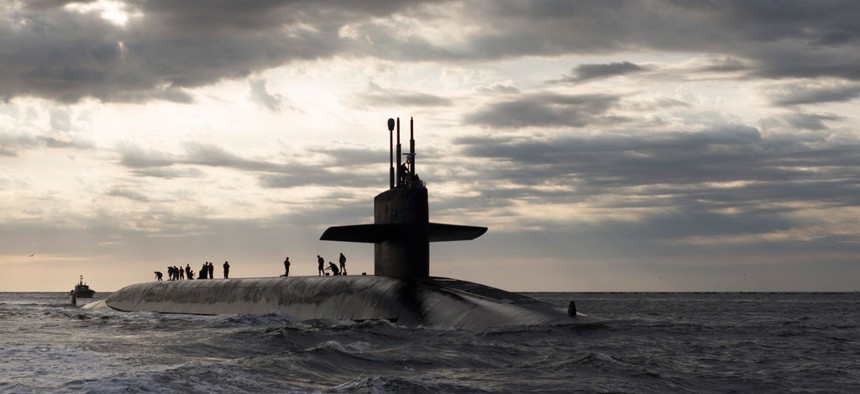
The USS Rhode Island, an Ohio-class ballistic missile submarine, returns to Naval Base Kings Bay in March 2013. U.S. Navy photo by Mass Communication Specialist 1st Class James Kimber
Funding to Replace Nuclear Subs Up in the Air
Replacing the Ohio-class ballistic-missile sub won't happen this year, though that doesn't mean Congress is out of options yet. By Elaine M. Grossman
A key U.S. House panel leader says Congress won't create a special funding stream for nuclear-armed submarines this year, but he thinks the idea of bankrolling the vessels outside of the Navy's strained shipbuilding budget is almost certain in the long term.
Representative Randy Forbes (R-Va.) told reporters on Tuesday morning that replacing today's Ohio-class ballistic-missile vessels "is a national strategic concern" that cannot be allowed to fall victim to an already underfunded naval ship-procurement plan in coming decades.
That plan, by his estimates, is $4 billion to $6 billion short annually.
Some Navy leaders and members of Congress have advocated that as a "national strategic asset," the purchase of 12 new "SSBN(X)" submarines armed initially with Trident D-5 nuclear-tipped missiles should have its own dedicated funding source outside of the service's normal budget.
The idea would be to help ensure that this leg of the U.S. nuclear triad continues to be resourced, and is not cut to help fund other Navy priorities in its plan to field 300-plus combat vessels.
Navy leaders have testified that the Ohio-class replacement program is their top ship-construction priority, and they would cut purchases of other vessels, if need be, to fund the nuclear-armed submersibles. If the Ohio-class replacement submarine goes forward as planned under a single shipbuilding budget, Navy brass have said they might be able to sustain a fleet of just 250 vessels.
However, Forbes sees a growing need for U.S. seapower in the Asia-Pacific region and around the globe. He said he can't imagine how the Navy could realistically fund the nuclear-equipped vessels -- a program estimated at more than $90 billion -- and still have funds to buy enough of other classes of required warships.
"If you don't do that [separate-funding scheme], basically we're going to be taking our entire shipbuilding budget to do that [ballistic-missile submarine], and that would be very, very dangerous for the country," said Forbes, who chairs the House Armed Services Seapower and Projection Forces Subcommittee.
Speaking at a Defense Writers Group breakfast, he said the prospects that Congress as a whole would support a special funding scheme for the "boomer" submarines sometime in the future are "good because I think we're not going to have a choice."
Forbes blamed both Republican and Democratic lawmakers, as they review and alter federal budgets, for having typically "reached up and grabbed" desired funding numbers and said "make this fit." But "on national defense you can't do it," he said.
The Navy estimates it will need an average of $16.8 billion annually -- measured in fiscal 2013 dollars -- to underwrite its 30-year shipbuilding plan, which is more than $2 billion a year over historic averages, according to a recent Congressional Research Service report. The Congressional Budget Office says the Navy plan would actually require $19.3 billion on average each year, or $2.5 billion more than the service's estimates.
"I don't think Congress is going to want shipbuilding to stop completely," Forbes said. "And yet, we're not going to let the most powerful vessels we have in the world for national defense not be [built]."
However, he said U.S. legislators would likely "put it off until the last moment," as they tend to do on many matters of public policy.
"We're not there now," said the lawmaker, who has represented Virginia's 4th District since 2001. "I wish I could give you a timetable. I can't. But I do believe that's the right thing to do, and we're going to continue to push" the issue.
The Navy has requested $1.2 billion in SSBN(X) research and development funds for fiscal 2015, and plans to begin building the first such vessel in 2021. It is to be ready for fielding a decade later.




